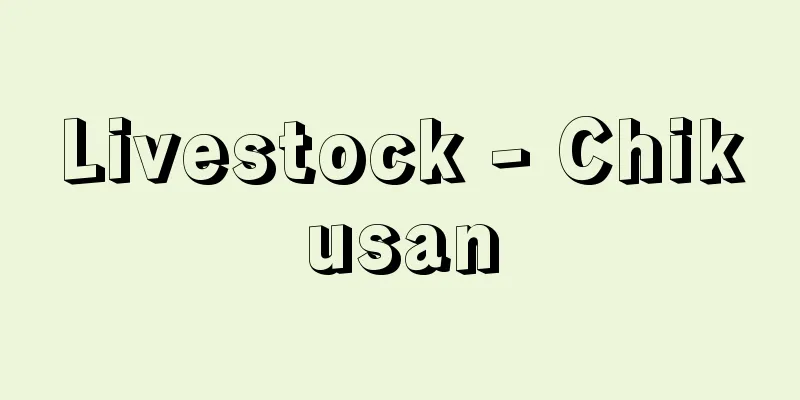Livestock - Chikusan

|
It is a production activity or industry in which domesticated animals, i.e. livestock, are raised under human control and tamed for the purpose of producing goods and services useful to humans, mainly by feeding them with crops and wild plants. It is a part of agriculture and is linked to crop cultivation through the supply of feed. Specifically, it refers to the raising of cattle, horses, pigs, sheep, goats, rabbits, poultry (chickens, ducks, turkeys, etc.), and other livestock for food (milk, meat, eggs), clothing (fur, skin), and work (cattle, riding, and feeding), but in a broader sense it also includes the production of dogs, cats, small birds, etc. for entertainment, and guinea pigs for laboratory animals. It may also include beekeeping, but sericulture is usually treated as an independent industry. [Tadashi Tadashi and Yoshiko Mori] Forms of livestock farmingLivestock farming is first classified by the type of livestock or livestock products being raised. For example, there is dairy farming (raising dairy cows to produce milk and dairy products), beef cattle to produce beef, pigs to produce pork, chicken farming (raising layers to produce eggs and meat chickens (broilers) to produce chicken meat), sheep farming for wool and mutton, etc. There is also combined production using dual-purpose species, such as cows for milk, chickens for eggs, and sheep for wool. Livestock farming can be broadly divided into pasture and barn-rearing, based on the management style centered on feeding. Pasture is when livestock are allowed to freely graze on feed crops and wild grasses, but pasture usually refers to when the animals are settled in one area, and nomadism is when they move from place to place in search of land with grass. Pasture includes forest grazing in mountain forests, grassland grazing in natural or improved grassland, and field grazing in farm fields after harvest. Barn-rearing, on the other hand, involves tying animals in livestock sheds and managing them, and there are various types, including grazing in the summer and barn-rearing in the winter, cultivating feed crops and barn-rearing all year round, and barn-rearing all year round on purchased concentrated feed. Finally, livestock farming can be categorized by the type of management. In capitalist countries, livestock farming is generally family-run, primarily for dairy farming and beef cattle raising, but large-scale capitalist enterprises can be found in pig and poultry farming. On the other hand, in some developing countries, livestock are still shared by communities, and large-scale socialist livestock management was once attempted in socialist countries. [Tadashi Tadashi and Yoshiko Mori] History of livestock farmingHumans first domesticated wild animals during the Postglacial Period, from around 10,000 BC to around 8,000-7,000 BC, in what is known as the Mesolithic Period. It is said that dogs were domesticated first, followed by goats and sheep. Cattle and pigs were domesticated during the Neolithic Period, from around 6,000-5,000 BC, and were associated with agricultural culture. Horses and chickens were domesticated somewhat later, around 2,000 BC. With the exception of chickens, which were domesticated in South Asia, most of these animals were domesticated in central Eurasia, and it is believed that they spread from there to all parts of the world along with agricultural civilization. With the dawn of ancient civilization, nomadic herding of sheep and goats began, and the raising of cattle and pigs, linked to settled agriculture, also spread. Horse keeping expanded primarily for military and transportation purposes. In ancient times, livestock keeping was not only carried out for practical purposes. Livestock were deeply linked to religion and superstition as objects of worship, sacrifices, and means of divination. Furthermore, owning livestock was itself a symbol of the authority of the ruling class. In Europe, the purpose of livestock farming became purely practical in the Middle Ages. The three-field farming method reduced fallow land and increased grain production, but eventually a technique was developed in which several horses pulled a plow with a repellent board, giving rise to the Great Reclamation Period (11th to 12th centuries). The premise for this was the improvement of horse equipment and the increase in the production of oats as feed. Cattle were grazed on common land or fallow land, mainly to maintain soil fertility and for milk and meat. Meanwhile, sheep farming developed in conjunction with the woolen textile industry, one of the largest industries in the Middle Ages. Pigs were the most important animal for food, and they were raised by grazing on oak nuts in forests or feeding them household waste in cities. The agricultural revolution in Europe began with the introduction of rotational farming, which added root vegetables and legumes to cereal crops, but this led to the raising of livestock in barns. This increased the number of livestock per unit area of cultivated land, and not only met the demand for dairy meat, which had risen sharply during the Industrial Revolution, but also made it possible to supply manure to maintain soil fertility and to improve modern breeds. Meanwhile, the industrial use of horsepower progressed with the Industrial Revolution, and until the practical application of steam engines, horses were the most important power source along with water power. In terms of fiber raw materials, wool, which had been used since the Middle Ages, was replaced by cotton. Sheep grazing moved from fertile grasslands to the less productive areas around them, and eventually in the second half of the 19th century, their production areas moved to the New World (the Americas) and Oceania. Around this time, not only sheep but also cattle raising increased in the New World and Oceania, and the center of world livestock farming shifted from Europe to the New World and Oceania. From the 1870s onwards, large amounts of grain were imported into Europe from the New World, followed by frozen meat and other livestock products. Grain prices fell, causing an agricultural depression, but as a result, arable land was converted to grassland in countries such as the UK, while chicken and pig farming, which relied on imported grain, was established. For example, it was during this period that pig farming, which relied on imported grain and by-products from brewing and sugar refining, developed in Germany. American livestock farming began with the introduction of horses, cattle, pigs, sheep, chickens, and other animals from the Old Continent. At the time of settlement on the East Coast, a small number of various livestock were raised in conjunction with the farming and household sectors. After the Civil War, the long drive to railroad terminals in places like Kansas began, capturing large numbers of wild cattle on the grasslands of Texas and sending them to railroad terminals, which gave livestock farming an independent business and industry. As the westward development progressed, the grazing of beef cattle in the drier West, dairy farming in the hilly areas of the Midwest and Northeast, and pig and chicken farming combined with corn production in the Corn Belt rapidly developed, and by the start of the 20th century, America had grown into the world's largest livestock-producing country. Japan's livestock farming began with the introduction of horses, cattle, chickens, and other animals from the continent and the domestication of wild boars after the Jomon and Yayoi periods. Until the Nara period, Japanese people commonly consumed beef, pork, milk, and dairy products, but with the introduction of Buddhism and the ban on meat consumption, meat consumption became uncommon, except in exceptional cases among the ruling classes. Horses were mainly kept in eastern Japan, while cattle were kept in western Japan, for the purpose of producing manure and for work (cattle were mainly used for agricultural work, which became widespread after the Middle Ages). With the exception of pig farming in the Ryukyu Islands and parts of Kyushu, pigs, goats, and sheep were not kept. It is a mistake to attribute Japan's shift to livestock-free agriculture simply to religious taboos. It can be said that natural and social conditions such as abundant marine products, a lack of grazing land, and small-scale rice paddy management, combined with religious values unique to the Japanese, have resulted in a food culture that lacks livestock products and a unique view of livestock. When the ban on meat consumption was lifted after the Meiji Restoration, dairy cattle and sheep were introduced from Europe and America to promote livestock farming, but it was not easy to break away from livestock-free agriculture that was centered on draft cattle. During the Meiji period, chicken farming in Aichi, pig farming in Kagoshima, and urban milking businesses were established as regional pioneers, but it was not until the Taisho period that pig farming in the Kanto and Tokai regions, beef cattle fattening in western Japan, and dairy farming in Hokkaido, Kanto, and Tokai were established along with the popularization of beef, pork, and milk consumption, and it was not until the early Showa period that Japan achieved domestic self-sufficiency in eggs. However, Japan's livestock farming, which had finally established a foundation in this way, suffered a devastating blow during World War II. [Tadashi Tadashi and Yoshiko Mori] Livestock in the worldBeef cattle breedingThere are approximately 1.34 billion cattle in the world (1999), distributed widely across all regions of the globe. By country, India leads the world with just over 210 million, followed by Brazil with 160 million, China with 110 million, the United States with 100 million, Argentina with 50 million, and Ethiopia, Sudan, Mexico, Russia, Colombia, Australia, Bangladesh, and France with 20-40 million each (this figure excludes water buffaloes, which number approximately 160 million, mainly in Asia). However, beef production in 1999, at approximately 55.68 million tons, was concentrated in the United States, at approximately 12.05 million tons, followed by South America (Argentina approximately 2.65 million tons, Brazil approximately 6.18 million tons), Europe (France approximately 1.56 million tons, Germany approximately 1.42 million tons), Oceania (Australia approximately 2 million tons), as well as China (4.67 million tons) and Russia (2.05 million tons). There are two types of beef production: the grain-fed method, where the cattle are fed grains during the fattening stage, and the grass-fed method, where the cattle are left to graze on pasture to be finished as beef. In the case of grain-fed beef, the beef contains fat, making it tender and rich in aroma and flavor. Roughly speaking, beef in Oceania and South America is grass-fed, while beef in the United States, Europe (and Japan) is grain-fed. Beef production thus requires land resources and a supply of roughage, and so tends to be concentrated in certain regions, but beef exports, which accounted for only 3.2% of world production (1998), are biased even further toward certain countries, and excluding intra-regional trade among European Union (EU) countries, the mainstream is north-south trade, with Oceania exporting to the United States and Japan, and South America to the Middle East and EU countries. The United States, the world's largest beef producer, exports less than 1% of its production, but it is working to increase exports to Japan and other countries by leveraging the quality of its grain-fed beef. [Tadashi Tadashi and Yoshiko Mori] dairyMilk production is concentrated in Europe, where the industry has a long history (43% share in 1999), and if Russia (6%) and the United States (15%) are added, the total exceeds three-fifths of world production. With the exception of large capitalist corporations found in some parts of the United States, dairy farms are typically family-run, with the cows grazing from spring to autumn and kept in barns fed with hay or silage in winter. Many developed countries regard milk and dairy products as a staple food, and have protective policies such as price supports and import restrictions. However, many countries are struggling with overproduction. Trade in dairy products is mainly conducted within the EU, as well as exports from the EU and Oceania, and imports from the United States and Japan. [Tadashi Tadashi and Yoshiko Mori] Sheep farmingSheep are widely raised in areas with little rainfall and poor grassland, including Oceania, China, Central Asia, the Indian subcontinent, the Middle East, Africa, and South America. However, the main trade of sheep, both wool and mutton, is exported from Oceania and South America to the EU countries, the United States, and Japan. [Tadashi Tadashi and Yoshiko Mori] Pig and poultry farmingPigs and chickens, which basically depend on concentrated feed, are widely raised in developed and semi-developed countries and are largely self-sufficient within the country (however, pigs are not raised in Islamic countries). In addition, the differences in production costs and wholesale prices between countries are much smaller than those for cattle and sheep. In the case of pork, the major producers are China (1999 production volume: 39.85 million tons), the United States (8.78 million tons), and Germany (3.7 million tons), but most developed countries produce between 1 and 3 million tons, and as a result, the trade volume is just under 3% of the world production (88.26 million tons in 1999). Most of this flow is intra-EU trade, with Japan's imports from other countries prominent elsewhere. The major egg-producing countries are China (1999 production volume: 17.35 million tons), the United States (4.88 million tons), Japan (2.52 million tons), and Russia (1.77 million tons). However, most developed countries produce between 500,000 and 1 million tons, and developing countries also produce to some extent, so the trade volume of eggs in the form of liquid eggs or powdered eggs is low. The same is true for chicken meat. In 1999, poultry meat production was in the US (approximately 16.01 million tons), followed by China (approximately 11.59 million tons), Brazil (approximately 5.04 million tons), and France (approximately 2.11 million tons), with Mexico, the UK, Japan, Thailand, Italy, Canada and others reporting production of between 1 and 1.7 million tons. However, there are no stable large exporting countries, and the share of exports in total production is low, which is similar to that of eggs. [Tadashi Tadashi and Yoshiko Mori] Livestock in JapanOverviewJapan's livestock industry, which was devastated during World War II, recovered to prewar levels in the early 1950s, but after 1955 (Showa 30), it developed dramatically against the backdrop of a sharp increase in livestock consumption accompanying high economic growth, but this was mainly pig and chicken farming using mixed feed made from imported grains. Dairy farming and beef cattle raising are also grain-intensive compared to Europe and the United States. As a result, Japan has become the world's largest importer of feed grains (as of 1998 (Heisei 10) it imports about 21 million tons, which is about 20% of world exports). The government is rushing to establish land-based livestock farming amid a rice surplus, but this is not easy. [Tadashi Tadashi and Yoshiko Mori] dairyThe government has been focusing on the development of dairy farming since the 1950s, and has promoted grassland dairy farming in Hokkaido, paddy field dairy farming in rice paddy areas, and upland dairy farming on reclaimed land. In 1965, the "Temporary Measures Law for Subsidies for Producers of Processed Raw Milk" (Law No. 112 of 1965) was enacted to support the price of raw milk through a deficiency payment system. After that, dairy farming became larger in scale, and production was concentrated in Hokkaido, and Japan achieved an average number of livestock comparable to EU countries. However, in the late 1970s, the oversupply of milk and dairy products became evident, and competition between Hokkaido and Honshu production areas intensified. After that, Hokkaido's share of livestock numbers increased year by year, reaching 47% in 1998, and its share of milk production was 42.4%. [Tadashi Tadashi and Yoshiko Mori] Beef cattle breedingWagyu cattle, which had been raised as beef cattle since before the Second World War, fell from 2.72 million in 1956 to 1.55 million in 1967 due to the mechanization of agriculture. Then, as beef consumption increased, the raising of dairy bull calves began, and the number of Wagyu cattle stopped decreasing, so the number of beef cattle raised was 2.84 million in 1998. Although many Wagyu cattle breeding operations are still small-scale, the scale of dairy cattle fattening operations is expanding, and since the 1980s, production areas have been concentrating in Hokkaido and southern Kyushu, instead of the Kinki, Chugoku, and Shikoku areas that were the focus until the 1950s (in 1998, 26% of dairy cattle were raised in Hokkaido, and 20% of Wagyu cattle were raised in Miyazaki and Kagoshima). In 1997, about 1.41 million tons of beef (on a carcass basis) were consumed, of which 17% was Wagyu beef, 11% was beef from fattening dairy male cattle, 8% was beef from aged dairy female cattle, and 64% was imported beef. Beef, along with pork, is listed at the Central Wholesale Meat Market, and its price is indirectly supported by the "Law Concerning Price Stabilization, etc. of Livestock Products" (Law No. 183 of 1961). The impact of the liberalization of beef imports in 1991 was greater on dairy breeds, which are in high demand for home use and have a high degree of substitutability with imported beef, than on Wagyu beef, which is in high demand from high-end restaurants and other establishments, and the price drop of dairy breeds has been more severe than that of Wagyu beef. [Tadashi Tadashi and Yoshiko Mori] Pig farmingPig farming, along with broiler chicken production, has shown great growth since the end of World War II, driven by demand as the most popular meat. Initially, large-scale fattening operations using urban waste materials became increasingly common, but as the main production areas expanded from the Kanto region to southern Kyushu, large-scale integrated operations using compound feed have also increased. Many of these are operated by non-agricultural capital, and distribution is increasingly being carried out by meat processing manufacturers and others who bypass the central wholesale market and directly ship boxed cuts of meat to supermarkets and other outlets. Incidentally, although growth in household pork consumption began to stagnate in the late 1970s, it has increased due to the growth of the restaurant industry and the ready-meal (prepared and semi-prepared food) industry, and in 1998 the annual pork supply per person was 16.19 kilograms. [Tadashi Tadashi and Yoshiko Mori] Poultry farmingIn the 1950s, egg-laying hens farmed on compound feed spread to northern Kanto, Tokai, Kinki, Chugoku, and Shikoku in the form of farm-raised chickens, but in the 1960s, large-scale production areas, including large-scale corporate chicken farming with non-agricultural capital, were formed in Tohoku and southern Kyushu. Eggs were washed, graded, and packaged at GP Centers (Grading & Packing Centers) and sent directly to supermarkets and other outlets. However, at the same time, consumption stagnated and overproduction occurred, and since the mid-1970s, the government has been adjusting production through administrative guidance, and the scale of the guidance has been gradually revised from the initial 3,000 or more chickens to 50,000 or more chickens in 1996. Japan had been raising young chickens and consuming chickens since before the Second World War, but after the war, the raising and consumption of broilers was introduced and developed. Because this involved mass consumption of feed, general trading companies with affiliated feed manufacturers integrated the production and supply of feed and chicks, and the raising, processing, and wholesale of broilers, promoting large-scale production and distribution. There is a large concentration of production areas, with the share of the three prefectures of Kagoshima, Miyazaki, and Iwate reaching 52% of the processing volume in 1998. [Tadashi Tadashi and Yoshiko Mori] "History of Livestock Industry in Japan: Meat and Dairy" by Kamo Giichi (1976, Hosei University Press)" ▽ "History of Livestock Culture" by Kamo Giichi (1973, Hosei University Press)" ▽ "History of Livestock Industry by F.E. Zoiner, translated by Kokubu Naokazu and Kimura Nobuyoshi (1983, Hosei University Press)" ▽ "Encyclopedia of Livestock Industry edited by Naito Motoo (1989, Yokendou)" ▽ "Internationalization and the Future of Japanese Livestock Industry" edited by Miyazaki Hiroshi (1993, Ie no Hikari Kyokai)" [Reference items] | | | | | | | | | | | | | farming | Silkworm farming | | |Source: Shogakukan Encyclopedia Nipponica About Encyclopedia Nipponica Information | Legend |
|
人間に有用な財・サービスの生産を目的に、馴化(じゅんか)され人間の管理下にある動物すなわち家畜を、おもに農作物や野生植物を飼料に用いて飼養する生産行為、または産業である。農業の一部であり、飼料供給を通して農作物栽培と結び付いている。具体的には、ウシ、ウマ、ブタ、ヒツジ、ヤギ、ウサギ、家禽(かきん)(ニワトリ、アヒル、シチメンチョウなど)、その他の家畜を、食用(乳、肉、卵)、衣用(毛、皮)、作業用(引用、乗用、駄用)に飼養することをさすが、広義には、愛玩(あいがん)娯楽用のイヌ、ネコ、小鳥等、実験動物用のモルモット等の生産も含める。また養蜂(ようほう)を含める場合があるが、養蚕は普通独立の産業として扱われる。 [田 忠・森 佳子] 畜産の形態畜産は、まず飼養する家畜ないし畜産物の種類によって分けられる。たとえば、牛乳・乳製品生産のための乳牛飼養=酪農、牛肉生産のための肉用牛飼養、豚肉生産のためのブタ飼養=養豚、鶏卵生産のための採卵鶏飼養および鶏肉生産のための肉用鶏(ブロイラー)飼養=養鶏、羊毛・羊肉生産のためのヒツジ飼養等々である。なお、ウシの乳肉、ニワトリの卵肉、ヒツジの毛肉のように、兼用種による結合生産もみられる。 畜産は、飼料給与を中心とする管理形態から、大きく放牧と舎飼いとに分けられる。家畜に飼料作物や野生の草を自由に採食させるのが放牧であるが、放牧は普通その土地に定着している場合をさし、草のある土地を求めて順次移動する場合は遊牧とよぶ。放牧には、山林に放牧する林地(間)放牧、自然草地・改良草地に放牧する草地放牧、収穫後の圃場(ほじょう)に放牧する圃場放牧などがある。一方、畜舎に係留して管理するのが舎飼いであるが、これには、夏季は放牧し冬期間舎飼いする場合、飼料作物を栽培して通年舎飼いする場合、購入濃厚飼料で通年舎飼いする場合などがある。 最後に、畜産はその経営形態で分けられる。資本主義国の畜産は、酪農、肉用牛飼養を中心に家族経営が一般的であるが、養豚、養鶏などで大規模な資本制企業がみられる。一方、一部の開発途上国には共同体による家畜の共有も残っており、またかつて社会主義国では大規模な社会主義畜産経営も試みられた。 [田 忠・森 佳子] 畜産の歴史人類が野生動物を初めて家畜化したのは、後氷期に入った紀元前1万年ごろから前8000~前7000年ごろの中石器時代とよばれる時期であり、まずイヌ、続いてヤギ、ヒツジを馴化したといわれる。ウシ、ブタの家畜化は、前6000~前5000年ごろからの新石器時代であり、農耕文化に伴うものであった。ウマとニワトリはやや遅れ、前2000年ごろと推定されている。これらが最初に馴化された場所は、南アジアで家畜化されたニワトリを除いて、ユーラシア大陸中央部がほとんどであり、そこから農耕文明とともに世界各地に拡散していったものと考えられている。 古代文明の黎明(れいめい)とともに、遊牧の形でのヒツジとヤギの群飼が始まり、また定着農耕と結び付いたウシやブタの飼養も広がった。ウマの飼養は主として軍事用・運搬用の目的で拡大した。古代の家畜飼養は、実用目的だけで行われていたのではない。家畜は、崇拝対象、いけにえ、卜占(ぼくせん)手段などの形で、宗教や迷信に深く結び付けられていた。また家畜所有それ自体が支配階級の権威のシンボルであった。 ヨーロッパにおいては、中世に入ると家畜飼養の目的は実用に純化された。三圃式農法は休閑地の減少と穀物生産の増大をもたらしたが、やがて撥土(はつど)板をもつプラウを数頭のウマが引くという技術が開発され、大開墾時代(11~12世紀)を生んだ。その前提は、馬具の改良と飼料としてのエンバクの生産増加である。ウシは、おもに地力維持と乳肉を目的に共有地や休閑地で放牧された。一方、中世最大の産業の一つである毛織物工業と結び付いて発展したのがヒツジ飼養である。また、食用としてもっとも重要であったのはブタであり、林間放牧でのカシの実の採食や都市内での家庭残滓(ざんし)物の給与によって飼養された。 ヨーロッパの農業革命は、穀作に根菜やマメ科牧草などを加えた輪栽式農法の導入に始まるが、それは家畜の舎飼いをもたらした。これにより、耕地面積当り家畜飼養頭数が増大し、産業革命で急増した乳肉需要がまかなわれただけでなく、地力維持のための厩肥(きゅうひ)供給や近代的品種改良も可能になった。一方、産業革命とともに馬力の工業的利用が進み、蒸気機関の実用化までの間、ウマは水力と並んでもっとも重要な動力源であった。また繊維原料では、中世以来の羊毛が綿花にとってかわられた。ヒツジの放牧は、肥沃(ひよく)な草地からその外延の低生産力地帯に移り、やがて19世紀後半、新大陸(アメリカ大陸)やオセアニアにその産地を移した。このころヒツジだけでなくウシの飼養も新大陸とオセアニアで増大し、世界の畜産の中心はヨーロッパから新大陸とオセアニアへ移動した。1870年代以降、ヨーロッパに大量の穀物が新大陸から輸入され、続いて冷凍肉などの畜産物も入ってきた。穀価が低落し、農業恐慌が引き起こされたが、その結果、イギリスなどで耕地が草地に転換され、他方で輸入穀物に依存する養鶏や養豚が成立した。たとえば、ドイツで輸入穀物や醸造・製糖副産物に依存する養豚が発展したのはこの時期である。 アメリカの畜産は、旧大陸からのウマ、ウシ、ブタ、ヒツジ、ニワトリなどの導入で始まった。東海岸への入植時は、少数の各種家畜が耕種・家計部門と結び付いて飼養されていた。南北戦争後、テキサスの草原で野生化したウシを大量にとらえ、カンザスなどの鉄道ターミナルまで送るロングドライブが始まり、これで畜産が経営および産業として独立した。その後西部開拓の進展とともに、雨量の少ない西部での肉用牛放牧、中西部や北東部の丘陵地に展開した酪農、コーンベルトのトウモロコシ生産と結合した養豚・養鶏などが急速に発展し、20世紀に入ると世界最大の畜産国に成長した。 日本の畜産は、縄文・弥生(やよい)期以降における大陸からのウマ、ウシ、ニワトリなどの導入やイノシシの家畜化などに始まる。奈良時代までの日本人は、牛肉、豚肉、牛乳・乳製品などを普通に消費していたが、仏教伝来に伴う肉食禁止令を機に、獣肉消費は支配階級による例外的なものを除いて一般にはみられなくなった。そして東日本ではウマ、西日本ではウシがおもに飼養されたが、その目的は厩肥生産と作業用であった(中世以降普及した農業での役(えき)利用はおもにウシ)。琉球(りゅうきゅう)と九州の一部でのブタ飼養を除き、ブタ、ヤギ、ヒツジの飼養もみられなかった。この日本の無畜農業化の原因を、単に宗教的タブーに求めるのは誤りである。豊かな水産物、採草放牧地の不足および零細な水田経営といった自然的・社会的条件に日本人独特の宗教的価値観が加わり、畜産物を欠く食文化と独自の家畜観が生まれたとみるべきであろう。 明治維新後の獣肉消費解禁とともに、欧米から乳肉用牛やヒツジが導入されて畜産振興が図られたが、役牛馬中心の無畜農業からの脱却は容易ではなかった。明治期に、愛知の養鶏、鹿児島の養豚、都市搾乳業者などが地域的な先駆として成立するが、関東・東海の養豚、西日本での肉用牛肥育、北海道・関東・東海の酪農が、牛豚肉や牛乳消費の大衆化とともに確立されるのは大正期以降であり、鶏卵の国内自給が成立するのは昭和初期である。しかし、このようにようやく基盤をつくった日本の畜産も、第二次世界大戦によって壊滅的な打撃を受けた。 [田 忠・森 佳子] 世界の畜産肉用牛飼養世界には約13億4000万頭のウシがいるが(1999)、それは世界の全地域に広く分布している。国別でみると、2億1000万頭強のインドを筆頭に、1億6000万頭のブラジル、1億1000万頭の中国、1億頭のアメリカ、5000万頭のアルゼンチン、2000万~4000万頭のエチオピア、スーダン、メキシコ、ロシア、コロンビア、オーストラリア、バングラデシュ、フランスと続く(アジアを中心に約1億6000万頭いるスイギュウを除く頭数である)。しかし、1999年の約5568万トンの牛肉生産は、約1205万トンのアメリカを筆頭に、南米(アルゼンチン約265万トン、ブラジル約618万トン)、ヨーロッパ(フランス約156万トン、ドイツ約142万トン)、オセアニア(オーストラリア約200万トン)のほか、中国(467万トン)、ロシア(205万トン)などに集中している。 牛肉生産には、肥育段階で穀物を与えるグレーンフェッド方式と、放牧のまま肉牛に仕上げるグラスフェッド方式の2種類がある。グレーンフェッドの場合、牛肉に脂肪が入るため、柔らかく、香りや味覚に富む。大まかにいって、オセアニアと南米の牛肉はグラスフェッドであり、アメリカ、ヨーロッパ(および日本の牛肉)はグレーンフェッドである。 このように土地資源と粗飼料供給を必須(ひっす)とする牛肉生産は、地域的な集中傾向を示すが、世界生産量の3.2%にすぎない牛肉輸出(1998)はさらに特定国に偏っており、ヨーロッパ連合(EU)諸国の域内貿易を除くと、オセアニアからアメリカおよび日本へ、南米から中東およびEU諸国へという南北貿易が主流である。世界最大の牛肉生産国アメリカの輸出量は生産量の1%以下にすぎないが、そのグレーンフェッド牛肉の品質を武器に日本などへの輸出増大に努めている。 [田 忠・森 佳子] 酪農牛乳生産は、歴史の古いヨーロッパに集中しており(1999年のシェア43%)、これにロシア(6%)、アメリカ(15%)を加えると、世界生産の5分の3を上回る。酪農経営は、アメリカの一部にみられる資本制大企業のような例外を除くと、典型的な家族経営が多く、春から秋へは放牧、冬は乾草やサイレージによる舎飼いという形態をとる場合が多い。牛乳・乳製品に関しては、多くの先進諸国が基幹食糧に位置づけており、価格支持や輸入制限などの保護政策をとっている。しかし一方で、過剰生産に苦慮している国が多い。乳製品の貿易は、EU諸国の域内貿易のほか、EUとオセアニアからの輸出、アメリカと日本の輸入がおもな流れである。 [田 忠・森 佳子] ヒツジ飼養ヒツジは雨量が少なく草生の乏しい地帯で大規模に放牧されており、オセアニア、中国をはじめ、中央アジア、インド亜大陸、中近東、アフリカ、南米などで広く飼養されている。しかし、貿易は、羊毛、羊肉とも、オセアニアおよび南米から、EU諸国、アメリカ、日本への輸出がおもな流れである。 [田 忠・森 佳子] 養豚・養鶏基本的に濃厚飼料に依存するブタとニワトリは、先進国や中進国を中心に広く飼養されており、国内自給的色彩が濃い(ただしイスラム諸国ではブタの飼養はみられない)。また、生産費や卸売価格の国別格差はウシやヒツジの畜産物のそれよりもずっと小さい。 豚肉の場合、中国(1999年の生産量約3985万トン)、アメリカ(約878万トン)、ドイツ(約370万トン)が大生産国であるが、先進国の多くは100万~300万トンの生産をあげており、その結果、貿易量は世界生産量(1999年で約8826万トン)の3%弱にすぎない。その流れもEUの域内貿易がおもであり、その他は日本の世界各国からの輸入が目だつだけである。 鶏卵では、中国(1999年の生産量約1735万トン)、アメリカ(約488万トン)、日本(約252万トン)、ロシア(約177万トン)が大生産国である。しかし、先進国の多くは50万~100万トンの生産を示しており、開発途上国でもある程度の生産がみられるため、液卵や粉卵の形をとる鶏卵貿易量は少ない。鶏肉も同様である。 1999年の家禽肉生産量は、アメリカ(約1601万トン)、中国(約1159万トン)、ブラジル(約504万トン)、フランス(約211万トン)に続いて、メキシコ、イギリス、日本、タイ、イタリア、カナダなどが100万~170万トンの生産量を示している。しかし、安定した大輸出国がなく、生産量に占める輸出量のシェアが低い点は鶏卵と共通する。 [田 忠・森 佳子] 日本の畜産概況第二次世界大戦で壊滅的打撃を受けた日本の畜産は、1950年代前半に戦前水準を回復したあと、1955年(昭和30)以降、高度経済成長に伴う畜産物消費急増を背景に飛躍的に発展したが、それは輸入穀物原料の配合飼料による養豚と養鶏が中心であった。酪農と肉用牛飼養も欧米に比べると穀物多給型である。その結果、日本は世界一の飼料穀物輸入国になった(1998年(平成10)現在、世界輸出の約20%にあたる約2100万トンを輸入している)。政府は、米過剰のなかで土地利用型畜産の確立を急いでいるが、容易ではない。 [田 忠・森 佳子] 酪農政府は1950年代から酪農の発展に力を入れ、北海道の草地酪農のほか、水田地帯での水田酪農、開墾地での畑地酪農などの推進に努めた。1965年(昭和40)には「加工原料乳生産者補給金等暫定措置法」(昭和40年法律112号)を制定し、不足払い制による原料乳の価格支持を図っている。その後、酪農経営の大規模化が進み、生産が北海道に集中するなかで、日本はEU諸国に準ずる平均飼養頭数を実現するに至った。しかし、1970年代後半に入ると、牛乳・乳製品の供給過剰が顕著になり、北海道と本州の産地間競争も激化するようになった。その後、北海道の飼養頭数シェアが年々増加し、1998年(平成10)には47%となり、また牛乳生産量シェアも42.4%となっている。 [田 忠・森 佳子] 肉用牛飼養第二次世界大戦前から役肉用牛として飼養されてきた和牛は、農業の機械化により1956年の272万頭から67年の155万頭まで減少した。その後牛肉消費の増大とともに、乳用種雄子牛の肥育が始まり、和牛飼養頭数も下げ止まったため、肉用牛飼養頭数は98年には284万頭になっている。和牛繁殖経営はまだ零細経営が多いが、乳用種肥育経営を中心に規模拡大が進んでおり、産地も1950年代までの近畿、中国、四国にかわって、1980年代以降は北海道、南九州に集中しつつある(1998年、乳用種の26%が北海道で、和牛の20%が宮崎、鹿児島で飼養されている)。 1997年に約141万トン(枝肉ベース)の牛肉が消費されたが、その17%が和牛、11%が乳用種雄肥育牛、8%が乳用種雌老廃牛の牛肉であり、64%が輸入牛肉である。牛肉は豚肉とともに食肉中央卸売市場に上場されており、また、「畜産物の価格安定等に関する法律」(昭和36年法律183号)で間接統制による価格支持がとられている。なお、1991年の牛肉輸入自由化による影響は、基本的に高級な料亭やレストラン等の需要が大きい和牛よりも、おもに家庭用で需要が大きく輸入牛肉と代替性が高い乳用種において強く出ており、乳用種の価格下落は和牛よりも激しいものとなっている。 [田 忠・森 佳子] 養豚養豚は、もっとも大衆的な食肉という需要を背景に、第二次世界大戦後、ブロイラーとともにその生産は大きな伸びを示している。当初は都市残滓物による肥育経営の大規模化が進んだが、主産地が関東だけでなく南九州に広がるにつれ、配合飼料による大規模一貫経営も増加している。そのなかには農外資本によるものも多くみられ、流通も、食肉加工メーカーなどが中央卸売市場を迂回(うかい)しながら箱詰め部分肉をスーパーマーケットなどへ直送する形が増えている。なお、家計における豚肉消費は、1970年代後半に入って伸び悩みが現れたが、外食産業、あるいは中食(調整済や半調理食品)産業の成長により豚肉消費量は増加し、1998年の1人当り年間の豚肉供給量は16.19キログラムとなっている。 [田 忠・森 佳子] 養鶏1950年代に配合飼料依存の採卵鶏飼養が農家養鶏の形で北関東、東海、近畿、中国、四国に広がったが、1960年代に入ると農外資本による企業的養鶏を含む大規模経営の大型産地が東北、南九州に形成された。そしてGPセンター(Grading & Packing Center)で洗選卵され包装されたパック卵がスーパーマーケットなどへ直送されるようになった。しかし同時に消費停滞と生産過剰が現れ、1970年代なかば以降、政府は行政指導による生産調整を行っており、その指導対象規模は、初期の3000羽以上から段階的に改正され、1996年度からは5万羽以上となった。 第二次世界大戦前から日本には若鶏肥育とかしわ消費があったが、戦後、ブロイラーの飼養と消費が導入されて発展した。これは飼料の大量消費を伴うため、飼料メーカーを系列にもつ総合商社が、飼料・素雛(もとびな)の生産供給、ブロイラーの飼養・処理・卸売りまでを統合し(インテグレーション)、生産と流通の大規模化を進めた。とくに産地の集中は大きく、1998年の処理量における鹿児島、宮崎、岩手3県のシェアは52%に達している。 [田 忠・森 佳子] 『加茂儀一著『日本畜産史 食肉・乳酪篇』(1976・法政大学出版局)』▽『加茂儀一著『家畜文化史』(1973・法政大学出版局)』▽『F・E・ゾイナー著、国分直一・木村伸義訳『家畜の歴史』(1983・法政大学出版局)』▽『内藤元男監修『畜産大事典』(1989・養賢堂)』▽『宮崎宏編『国際化と日本畜産の進路』(1993・家の光協会)』 [参照項目] | | | | | | | | | | | | | | | | |出典 小学館 日本大百科全書(ニッポニカ)日本大百科全書(ニッポニカ)について 情報 | 凡例 |
Recommend
Inagawa River
A river that flows through the southeastern part ...
Crèvecœur, Michel-Guillaume-Jean de
Born January 31, 1735 in Caen, Normandy [Died] Nov...
Ookurigani - Ookurigani
→ Hairy crab Source : Heibonsha Encyclopedia About...
Gigantopteridales
…Glossopteris are simple leaves with secondary ve...
Beneficial expenses - Yuuekihi (English spelling)
Expenses that contribute to increasing the value o...
Hokutolite (English spelling)
It is a variety of barite containing small amount...
Asconcentrum ampullaceum
…[Koichi Ejiri]. … *Some of the terminology that ...
Soft tissue
Parenchyma refers to plant tissues made up of par...
Körner, W.
…To establish chemistry in Japan, the Meiji gover...
Quetzaltenango (English spelling)
A city in southwestern Guatemala. It is the second...
Par value increase - Gakumenzoushi
When a corporation issues new shares to increase c...
Siberia and the Exile System
Based on his vivid experiences, he published Tent...
Agathis australis (English spelling) Agathisaustralis
… [Mitsuru Hotta]... *Some of the terminology tha...
Mandokoro - Mandokoro
〘 noun 〙① A place where government affairs are gen...
litter-feeder
…Soil animals are one of the life forms. Types of...









